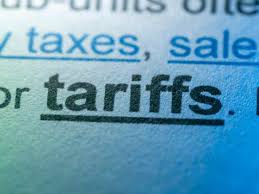
In recent years, trade policies have become a focal point of international economic discussions. A notable instance is Ukrainian President Volodymyr Zelensky's proposal to the United States, offering access to Ukraine's rare earth minerals in exchange for support and security guarantees. This move underscores the strategic importance of trade agreements in geopolitics. Concurrently, former U.S. President Donald Trump's advocacy for reciprocal tariffs has reignited debates on their efficacy and potential repercussions. This article delves into the concept of reciprocal tariffs, examines historical precedents, and analyzes their potential impacts on the global economic landscape.
Understanding Reciprocal Tariffs
Reciprocal tariffs are trade policies where a country imposes tariffs on imports equivalent to the tariffs its exports face in foreign markets. This approach aims to establish a level playing field by ensuring that trading partners impose similar duties on each other's goods. Unlike traditional protectionist tariffs designed solely to shield domestic industries, reciprocal tariffs are intended to promote fairness in international trade by mirroring the trade barriers imposed by other nations.
The concept of reciprocal tariffs is not new in U.S. trade policy. The Reciprocal Tariff Act of 1934 empowered the U.S. president to negotiate bilateral trade agreements that mutually reduced tariffs, marking a significant shift from the high protectionist barriers of the Smoot-Hawley Tariff Act of 1930. While the 1934 Act facilitated trade liberalization and economic recovery during the Great Depression, the Smoot-Hawley Act had exacerbated economic downturns by triggering retaliatory tariffs and stifling international trade. These historical instances highlight the delicate balance required in implementing tariff policies to avoid adverse economic consequences.
Global Trade Imbalances and Justifications for Tariffs
Trade imbalances, where one country imports more than it exports to a particular partner, have been a longstanding concern in international economics. Proponents of reciprocal tariffs argue that they can correct such imbalances by encouraging trading partners to lower their tariffs or face equivalent barriers. For example, if Country A imposes a 10% tariff on goods from Country B, a reciprocal tariff would allow Country B to impose a similar 10% tariff on imports from Country A. This strategy aims to incentivize countries to negotiate lower tariffs mutually, promoting fairer trade practices.
The implementation of reciprocal tariffs can have varied effects across different sectors. Industries that face high foreign tariffs may benefit from increased protection and leverage in negotiations. However, sectors reliant on imported components, such as automotive and technology industries, could experience increased production costs. For instance, U.S. automakers like General Motors, Ford, and Stellantis N.V. might encounter higher costs for imported parts, potentially leading to increased vehicle prices for consumers. Additionally, agricultural sectors could face retaliatory tariffs, affecting exports of products like soybeans and corn.
The introduction of reciprocal tariffs is likely to elicit varied responses from global trading partners. Some nations may seek negotiations to reduce existing tariffs and avoid potential trade conflicts. Others might retaliate by imposing their own tariffs on U.S. exports, leading to escalating trade tensions. Such actions could disrupt global supply chains, affect international alliances, and contribute to economic uncertainty. The geopolitical landscape would play a crucial role in determining the outcomes of such trade policies.
Economic and Consumer Impact
While reciprocal tariffs aim to protect domestic industries, they can also lead to higher consumer prices. Increased tariffs on imported goods often result in higher costs for businesses, which may be passed on to consumers. Moreover, trade restrictions can lead to supply shortages, further driving up prices. Economic analyses suggest that while certain industries might experience short-term gains, the broader economy could face challenges such as inflationary pressures and reduced purchasing power for consumers.
Some policymakers advocate for using tariff revenues to address budget deficits. However, the effectiveness of this approach is debatable. While increased tariffs can generate additional government revenue, they may also suppress economic activity by increasing costs for businesses and consumers. Furthermore, retaliatory measures from trading partners can reduce export revenues, potentially offsetting any fiscal gains. Therefore, relying on tariffs as a primary tool for budget balancing may not yield the desired economic outcomes.
Trump’s Trade Strategy in a Political Context
Former President Trump's advocacy for reciprocal tariffs aligns with his broader "America First" agenda, emphasizing the protection of domestic industries and the correction of perceived unfair trade practices. This approach garnered support from sectors adversely affected by foreign competition but also faced criticism from free trade proponents who warned of potential economic isolation and retaliation. The political discourse surrounding this strategy reflects deep divisions regarding the role of protectionism in modern economic policy.
Legal and WTO Considerations
The implementation of reciprocal tariffs raises legal questions, particularly concerning World Trade Organization (WTO) rules. The WTO aims to promote free and fair trade among nations, and unilateral tariff increases could be challenged as violations of international agreements. Countries affected by such tariffs might file disputes with the WTO, leading to prolonged legal battles and potential sanctions. Therefore, it's essential to consider the legal frameworks governing international trade when formulating tariff policies.
Instead of implementing reciprocal tariffs, countries can explore alternative strategies to address trade imbalances and protect domestic industries. Negotiating free trade agreements, engaging in diplomatic dialogues to reduce trade barriers, and investing in domestic competitiveness are viable options. Additionally, diversifying supply chains and reducing dependence on specific markets can enhance economic resilience without resorting to protectionist measures.
Reciprocal tariffs represent a strategic tool in trade policy, aiming to promote fairness and protect domestic industries. However, their implementation carries significant risks, including potential trade wars, economic inefficiencies, and legal challenges. A comprehensive analysis, considering historical precedents, economic impacts, and geopolitical consequences, is
(Source:www.bloomberg.com)
Understanding Reciprocal Tariffs
Reciprocal tariffs are trade policies where a country imposes tariffs on imports equivalent to the tariffs its exports face in foreign markets. This approach aims to establish a level playing field by ensuring that trading partners impose similar duties on each other's goods. Unlike traditional protectionist tariffs designed solely to shield domestic industries, reciprocal tariffs are intended to promote fairness in international trade by mirroring the trade barriers imposed by other nations.
The concept of reciprocal tariffs is not new in U.S. trade policy. The Reciprocal Tariff Act of 1934 empowered the U.S. president to negotiate bilateral trade agreements that mutually reduced tariffs, marking a significant shift from the high protectionist barriers of the Smoot-Hawley Tariff Act of 1930. While the 1934 Act facilitated trade liberalization and economic recovery during the Great Depression, the Smoot-Hawley Act had exacerbated economic downturns by triggering retaliatory tariffs and stifling international trade. These historical instances highlight the delicate balance required in implementing tariff policies to avoid adverse economic consequences.
Global Trade Imbalances and Justifications for Tariffs
Trade imbalances, where one country imports more than it exports to a particular partner, have been a longstanding concern in international economics. Proponents of reciprocal tariffs argue that they can correct such imbalances by encouraging trading partners to lower their tariffs or face equivalent barriers. For example, if Country A imposes a 10% tariff on goods from Country B, a reciprocal tariff would allow Country B to impose a similar 10% tariff on imports from Country A. This strategy aims to incentivize countries to negotiate lower tariffs mutually, promoting fairer trade practices.
The implementation of reciprocal tariffs can have varied effects across different sectors. Industries that face high foreign tariffs may benefit from increased protection and leverage in negotiations. However, sectors reliant on imported components, such as automotive and technology industries, could experience increased production costs. For instance, U.S. automakers like General Motors, Ford, and Stellantis N.V. might encounter higher costs for imported parts, potentially leading to increased vehicle prices for consumers. Additionally, agricultural sectors could face retaliatory tariffs, affecting exports of products like soybeans and corn.
The introduction of reciprocal tariffs is likely to elicit varied responses from global trading partners. Some nations may seek negotiations to reduce existing tariffs and avoid potential trade conflicts. Others might retaliate by imposing their own tariffs on U.S. exports, leading to escalating trade tensions. Such actions could disrupt global supply chains, affect international alliances, and contribute to economic uncertainty. The geopolitical landscape would play a crucial role in determining the outcomes of such trade policies.
Economic and Consumer Impact
While reciprocal tariffs aim to protect domestic industries, they can also lead to higher consumer prices. Increased tariffs on imported goods often result in higher costs for businesses, which may be passed on to consumers. Moreover, trade restrictions can lead to supply shortages, further driving up prices. Economic analyses suggest that while certain industries might experience short-term gains, the broader economy could face challenges such as inflationary pressures and reduced purchasing power for consumers.
Some policymakers advocate for using tariff revenues to address budget deficits. However, the effectiveness of this approach is debatable. While increased tariffs can generate additional government revenue, they may also suppress economic activity by increasing costs for businesses and consumers. Furthermore, retaliatory measures from trading partners can reduce export revenues, potentially offsetting any fiscal gains. Therefore, relying on tariffs as a primary tool for budget balancing may not yield the desired economic outcomes.
Trump’s Trade Strategy in a Political Context
Former President Trump's advocacy for reciprocal tariffs aligns with his broader "America First" agenda, emphasizing the protection of domestic industries and the correction of perceived unfair trade practices. This approach garnered support from sectors adversely affected by foreign competition but also faced criticism from free trade proponents who warned of potential economic isolation and retaliation. The political discourse surrounding this strategy reflects deep divisions regarding the role of protectionism in modern economic policy.
Legal and WTO Considerations
The implementation of reciprocal tariffs raises legal questions, particularly concerning World Trade Organization (WTO) rules. The WTO aims to promote free and fair trade among nations, and unilateral tariff increases could be challenged as violations of international agreements. Countries affected by such tariffs might file disputes with the WTO, leading to prolonged legal battles and potential sanctions. Therefore, it's essential to consider the legal frameworks governing international trade when formulating tariff policies.
Instead of implementing reciprocal tariffs, countries can explore alternative strategies to address trade imbalances and protect domestic industries. Negotiating free trade agreements, engaging in diplomatic dialogues to reduce trade barriers, and investing in domestic competitiveness are viable options. Additionally, diversifying supply chains and reducing dependence on specific markets can enhance economic resilience without resorting to protectionist measures.
Reciprocal tariffs represent a strategic tool in trade policy, aiming to promote fairness and protect domestic industries. However, their implementation carries significant risks, including potential trade wars, economic inefficiencies, and legal challenges. A comprehensive analysis, considering historical precedents, economic impacts, and geopolitical consequences, is
(Source:www.bloomberg.com)





